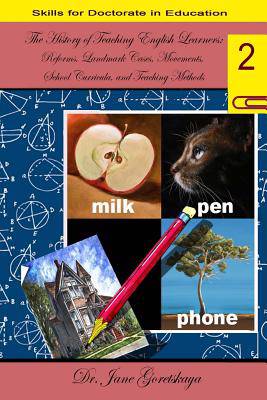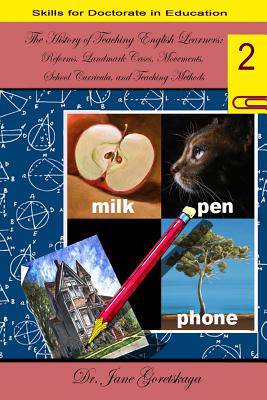
- Afhalen na 1 uur in een winkel met voorraad
- Gratis thuislevering in België vanaf € 30
- Ruim aanbod met 7 miljoen producten
- Afhalen na 1 uur in een winkel met voorraad
- Gratis thuislevering in België vanaf € 30
- Ruim aanbod met 7 miljoen producten
Zoeken
The History of Teaching English Learners
Reforms, Landmark Cases, Movements, Sc
Marina Bichinsky, Jane Goretskaya
Paperback | Engels | Anatomy of the World of Teaching English Learners: Alternative Methods of Instruction | nr. 2
€ 64,45
+ 128 punten
Omschrijving
Book 2. The History of Teaching English Learners: Reforms, Landmark Cases, Movements, School Curricula, and Teaching Methods Chapter 1 of book 2 introduces the scope of the literature concerning the influence of both traditional and alternative methods of instruction on English Learners' academic and communication achievements. The literature review includes two subtopics: (a) historical overview and (b) contemporary findings. The historical overview section includes a comprehensive discussion of findings regarding the problem of equity and adequacy of education for all students, especially Limited English Proficiency students, the background of the problem, and what has been done to resolve the dilemma in term of finding solutions that include alternative delivery methods, used for teaching disadvantaged and LEP students. The literature review includes extended information, taken from more recent publications, in comparison with information given in all-in-one book (1st edition). The contemporary findings section provides a framework for collecting and analyzing the literature on alternative methods of instruction on LEP students' academic and communication achievements. Chapter 2 of book 2 elaborates on the information given in Chapter 2 of the Book 1 regarding population, sampling, data collection procedures, and the rationale for the study. The chapter includes a discussion on the reliability and validity of the survey instrument and the appropriateness of the research design and methods to the goals of the study. The data collection techniques and the methods of data analysis are described. The purpose of the study was to investigate the influence of art education and distance learning on LEP students' academic achievement in regular K-12 public schools. The goal was to develop a broader understanding of the role of art education and distance learning in the development of English learners' ability to master communication skills and to learn English, language arts, mathematics, and science. The most effective methods and programs for teaching LEP students could be identified and implemented as a result of such understanding.
Specificaties
Betrokkenen
- Auteur(s):
- Uitgeverij:
Inhoud
- Aantal bladzijden:
- 142
- Taal:
- Engels
- Reeks:
- Reeksnummer:
- nr. 2
Eigenschappen
- Productcode (EAN):
- 9781505273663
- Verschijningsdatum:
- 28/11/2014
- Uitvoering:
- Paperback
- Formaat:
- Trade paperback (VS)
- Afmetingen:
- 152 mm x 229 mm
- Gewicht:
- 272 g

Alleen bij Standaard Boekhandel
+ 128 punten op je klantenkaart van Standaard Boekhandel
Beoordelingen
We publiceren alleen reviews die voldoen aan de voorwaarden voor reviews. Bekijk onze voorwaarden voor reviews.











